Media
Transcript
Today we found our inboxes bursting with news of all kinds, so today is going to be a bit more crammed together than normal.
Our first story of the day is all about the Sun. This nearest star to Earth both warms our days and periodically kills our spacecraft with its outbursts. While clearly it’s nice to be warm, we like our spacecraft, and figuring out how to better live with our Sun’s weather is the goal of space weather researchers. For 200 years, folks have been finding ways to study the surface of our Sun and its changing starspots, and for nearly 100 years, folks have been finding ways to also study the massive solar flares and coronal mass ejections that we see as vibrant auroras.
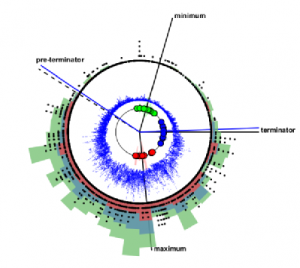
On their own, sunspots are harmless, but those other two events – flares and mass ejections – can include enough high energy particles to affect our high-tech infrastructure. In the past, we’ve seen the power grid in parts of Canada go down as these particles excited our planet’s magnetic field, which in turn drove charge through power lines until they collapsed. We’ve seen satellites get their electronics fried, and we’ve seen historical data that indicates the flares we’ve seen in recent decades are mild compared to some in the past. So how do we predict when these massive flares and ejections are coming?
According to new work from scientists at the University of Warwick, exact predictions remain impossible – the Sun can generate dangerous weather events at any time – but we now know that the greatest events are likely to occur when the Sun is experiencing what Solar Maxima. Over an eleven-year cycle, the Sun’s magnetic field can invert, and as the field goes from quietly aligned with one of the Sun’s rotational axes to quietly aligned with its other axis, it will go from having virtually no sunspots to being covered in sunspots when that magnetic field is most tangled. That maximum magnetic field chaos and maximum sunspot period is solar max, and it is then that we need to worry. By combining 200 years of sunspot data with 150 years of geologic and other records of geomagnetic storms triggered by the Sun, this team, led by Sandra Chapman, shows that 1-3% of activity occurs during minimum and as the Sun’s activity ramps up, so does the likelihood of bad solar weather. According to Chapman: The ability to estimate the risk of a future solar superstorm occurring is vital for space and ground-based technologies that are particularly sensitive to space weather, such as satellites, communications systems, power distribution, and aviation.
If you have a system sensitive to space weather you need to know how likely a big event is, and it is useful to know when we are in a quiet period as it allows maintenance and other activities that make systems temporarily more fragile.
This is particularly relevant for future plans to put humans on the Moon and send them to Mars. Currently, we don’t have any artificial radiation protection for them, and our best hope will be to send people on these grand explorations when the Sun is most quiet.
Let’s face it, the universe doesn’t make it easy on us. It is filled with dangerous objects, including apparently our own Sun, and it is changing in ways that are incredibly hard to understand.
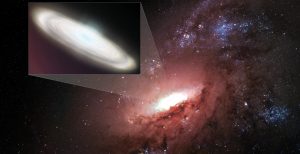
One mystery that keeps getting harder and harder to explain is the expansion rate of the universe. Since everything that is once occupied a single point and now occupies an undefined and vast volume, we know expansion happened. By using objects of known luminosity, we can measure the distance to galaxies in the near to middle-distance of our universe and then use doppler shift measurements to get their velocity the same way a speed trap clocks your car’s velocity. Using complex models and measurements, we can also get at the expansion rate by looking at various facets in the early universe, including the cosmic microwave background radiation. Back when our measurements had large error bars, all the measurements were consistent, but as our data has gotten better, the agreement between the expansion rate measured from things going on in the early universe and the rate measured from things going more recently have fallen into a disagreement. This could mean our ability to measure distances is wrong, or that our physics is wrong. I’m not going to lie – I’ve been hoping we’d find a measurement error.
Today, however, a new paper in the Astrophysical Journal Letters by lead author Dom Pesce finds that measurements of the expansion rate that use masers as standard candles are consistent with measurements from supernovae and gravitationally lensed quasar geometry, but do not match the early universe measurements. This means there is something wrong with our physics. This is terribly exciting – we have a new problem – and also kind of terrible because we have a new problem. This isn’t to say our physics is necessarily wrong – although that’s always an option. In all likelihood, we have some term missing or some assumption is just wrong and when we run the numbers… it’s like forgetting to include the dog in the household budget, things just don’t work out as expected and everything falls a little short. Add in that missing term, and everything works.
There are lots of times in science that we find things need revising over time. The one place that so far hasn’t been the case is relativity.
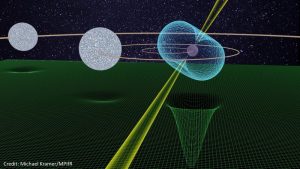
In other news, we have confirmation that even under relativistic conditions, objects of different masses will still fall at the same rate under the same force of gravity. We’ve all seen the experiments where people drop things like a feather and a brick in a vacuum and they both fall the same way. That experiment is hard, but doable here on Earth. Testing things under relativistic conditions, however, required finding a triple star system of truly massive proportions. The system, PSR J0337+1715, contains a neutron star that is a pulsar and two white dwarf stars of two different masses. The 366 beats-per-second rotation of the pulsar gets shifted by the gravitational pull of the two white dwarfs and allows direct measurement of how they are falling around the pulsar. After making a whole lot of measurements, it was clear both objects fall the exact same way, showing once again that Einstein got it right when he figured out relativity.
Finally, we have a few news notes to share in rapid succession:
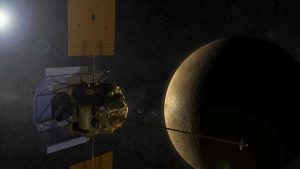
Astronomers at Durham and Johns Hopkins universities have used MESSENGER data to confirm the lifetime of free neutrons in space. The neutrons in question were generated on or near the surface of Mercury and then detected by the orbiting spacecraft. This required the neutrons to have a thirteen-minute life, give or take 130 seconds, and is consistent with the measurements made here on earth where neutrons aren’t so much free as they are trapped in containers where they can’t interact with other particles. This is also consistent with our Standard Model of Particle Physics, so yay.
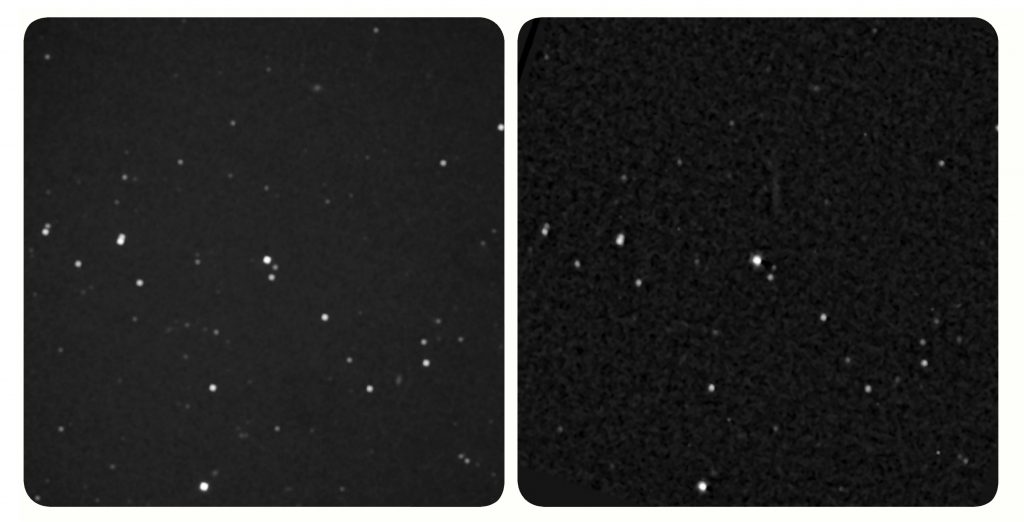
Filed under “What would happen if you put a telescope at the edge of the Solar System”, the New Horizons team has obtained simultaneous observations from the Earth and New Horizons of two nearby stars. These images show with remarkable clarity the jump in the position of those nearby stars compared to background objects when observed from these two different points. This is the star equivalent of holding your thumb up, blinking between your eyes, and seeing your thumb move relative to the background. These measurements confirm what we’ve seen using a lot more painstaking analysis. We’re still waiting on the publication to tell us more about the accuracy compared to other instruments like Gaia. This data was taken in April, and each byte took just under 6.5 hours to get to earth.
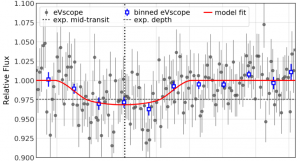
In more news of little scopes done good, the SETI Institute, working in partnership with Unistellar, has published data from a network of amateur astronomers using telescopes an average person could pick up and carry. That data confirm a planet orbiting Qatar-1 and has precisely measured the distance to the asteroid 2000 UD52. This proof-of-concept science shows, once again, that backyard astronomy is part of how we understand our universe and paves the way for folks to do more and more projects in the future.
Learn More
New ‘sun clock’ quantifies extreme space weather switch on/off
- University of Warwick press release
- “Quantifying the Solar Cycle Modulation of Extreme Space Weather,” S. C. Chapman et al., 2020 May 30, Geophysical Research Letters
New Distance Measurements Bolster Challenge to Basic Model of Universe
- National Radio Astronomy Observatory (NRAO) press release
- “The Megamaser Cosmology Project. XIII. Combined Hubble Constant Constraints,” D. W. Pesce, 2020 Feb. 26, Astrophysical Journal Letters (Preprint on arxiv.org)
Confirming Einstein’s Most Fortunate Thought
- Max Planck Institute for Radio Astronomy (MPIfR) press release
- “An Improved Test of the Strong Equivalence Principle with the Pulsar in a Triple Star System,” G. Voisin et al., 2020 June 10, Astronomy & Astrophysics (Preprint on arxiv.org)
First space-based measurement of neutron lifetime
- Durham University news article
- “Space-Based Measurement of the Neutron Lifetime Using Data from the Neutron Spectrometer on NASA’s MESSENGER Mission,” J. T. Wilson et al., 2020 June 11, Physical Review Research
NASA’s New Horizons Conducts the First Interstellar Parallax Experiment
Detecting Exoplanets and Asteroids: First Citizen Science Successes for Backyard Astronomy
Credits
Written by Pamela Gay
Hosted by Pamela Gay
Audio and Video Editing by Ally Pelphrey
Content Editing by Beth Johnson
Intro and Outro music by Kevin MacLeod, https://incompetech.com/music/


 We record most shows live, on Twitch. Follow us today to get alerts when we go live.
We record most shows live, on Twitch. Follow us today to get alerts when we go live.